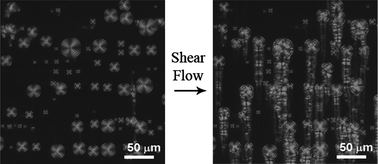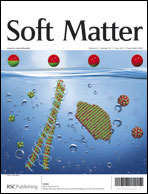Interaction of toroidal focal conic defects with shear flow
Abstract
Toroidal focal conic defects form in smectic liquid crystals due to antagonistic surface anchoring conditions. The resulting layer structure, defect size, and the formation of ordered patterns of defects have been studied in detail. Here, we investigate the effect of shear flow on toroidal focal conic defects. The defects are formed and subjected to a steady linear Couette flow in a microscale shear cell. In situ visualization of the evolution of the polarization texture of individual defects reveals the impact of three distinct flow regimes on the layer structure. At low Ericksen numbers, individual defects exhibit an early time elastic regime in which the optical intensity of the layer structure does not change in the presence of the applied shear flow. At increasing applied strains, the defect layer structure deforms, resulting in a monotonically increasing optical intensity within its original footprint. At even larger applied strains, satellite defects are emitted from the anchored defect. Cessation of shear flow at moderate strains, prior to the formation of satellite defects, leads to an exponential decay of the polarization intensity of the defect, suggesting that relaxation of the layer structure occurs with a time constant that is consistent with that predicted by a permeation flow mechanism. This study establishes the relevant length and time scales involved in the interaction of shear stresses and elastic stresses in smectic liquid crystalline samples whose structure deviates significantly from an idealized aligned lamellar configuration.


 Please wait while we load your content...
Please wait while we load your content...